Nicosia (Lefkosa or Lefkosia)
Cyprus
 |
| The Venetian Column |
According to Assyrian sources from the 7th Century BC, today's Nicosia then used to be a city named Ledra. In about 300 BC, the son of the Egyptian king Ptolemy, Lefkos, rebuilt the city, and his name is immortalised in the modern local name of Lefkosa (Turkish) or Lefkosia (Greek). Nicosia is the Frankish name of the city, and is thought to have appeared in the late 1100s. The name is mostly used by foreigners. The capital of the island, it is divided into Turkish and Greek sectors by a boundary known as the green Line, which runs in an East-west direction.
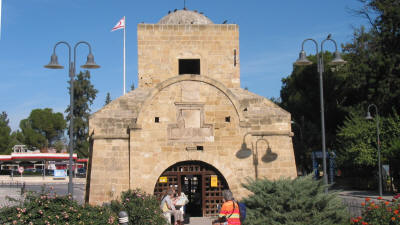 |
| The Kyrenia Gate |
In 1191, Richard the Lionheart, on his way to the Holy Land during the Third Crusade, captured the island as a response to actions against his fleet by the King of Cyprus. It was in Cyprus that Richard married Berengaria of Navarre, who was chosen as his wife by his mother, Queen Eleanor of Aquitaine. Cyprus remained under Richard's rule for only a year.
In 1192, he sold it to the Knights Templars who ruled the island from Nicosia. Life under the Templars was harsh, and they quickly incurred the hatred of the islanders. Unable to hold the island by force, the Templars begged Richard to take the island off their hands, and he quickly sold it to Guy de Lusignan who had lost his Kingdom of Jerusalem.
Nicosia has been the capital city of Cyprus since this time, and it flourished during the Lusignan era. Churches and palaces were built, and Nicosia grew in size and population. This glorious period in the history of the city ended in 1489 when the Venetians captured Cyprus.
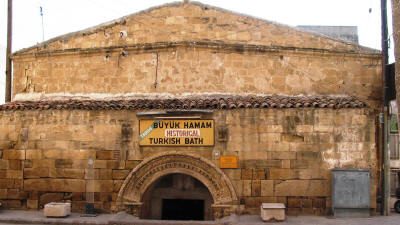 |
| The Buyuk Hamam |
The Venetians demolished most of the Lusignan monuments, including churches and palaces, and used the masonry to fortify the city against the anticipated Ottoman invasion. In 1567, just before the conquest of Cyprus by the Ottomans, the Venetians started to build new protective walls in place of the old Lusignan walls ringing the city, so as to be able to defend Nicosia. A famous Venetian engineer, Guillio Savorignano drew the plans for the walls. They were to have a circumference of three miles, 11 bastions, each like a castle, and three gates. The remnants of the walls still encircle the old city today. The three gates were the Kyrenia Gate in the north, the Famagusta Gate in the east, and the Paphos Gate in the west. The Kyrenia Gate is still intact today, and remains as an attractive historic monument of northern Nicosia.
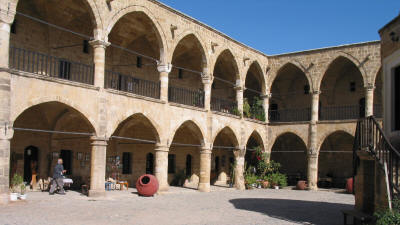 |
| The Buyuk Han |
In order to build the walls, the Venetians demolished houses, palaces, monasteries and churches outside the three mile circumference of the city, and used their stone in the construction of the walls. Consequently, there is no trace of the medieval settlement that once existed. However, their efforts did not prevent the island from falling to the forces of the Ottoman admiral Lala Mustafa Pasha in 1570, and thus the Venetians were defeated by the Ottomans before they had time to completive the construction of the walls.
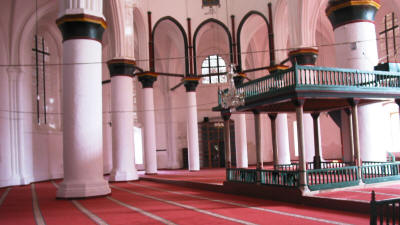 |
| Selimiye Mosque |
After the conquest, the city gained new vigour, and mosques, baths and other institutions to meet the requirements of its new masters were established, and a new building activity began. Yet, to our day, the city has kept its oriental charm of a peaceful oasis where softly and beautifully shaped palm trees overhang the roofs.
In the old city, beautiful examples of Gothic and Ottoman architecture abound; the Selimiye Mosque, the Bedesten, and the Great Inn, to name just a few. Recent years have seen a renewed interest in urban regeneration which has seen many buildings sympathetically restored as part of the Nicosia Master Plan.
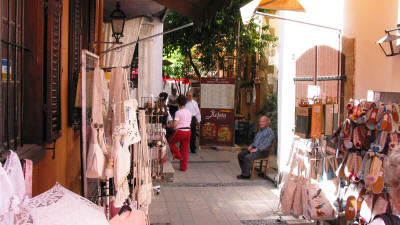 |
| The Laiki Geitonia Area |
If your time in Nicosia is limited, perhaps the best way to get a flavour of the city is to take one of the free walking tours. These last for two hours, and look at the Mevlevi Museum, Samanbahce houses, The Venetian Column, the Great Inn, Selimiye Mosque, the Eaved House, Arasta and many other historical landmarks. These start at the Kyrenia Gate for North Nicosia, while a similar tour starts at the TIC in the Laiki Geitonia area (off the southern end of Ledra Street) for South Nicosia. (Remember, if you are going to cross from north to south, you will need your passport)
Nicosia, the capital of both North and South Cyprus, is currently the biggest and most densely populated city on the Island. The developing, urban, yet historic and charming city of Nicosia is the major centre for arts, culture, diplomacy and business.
For a comprehensive list of places to visit, look at our Places of Interest sections for North Nicosia or South Nicosia.